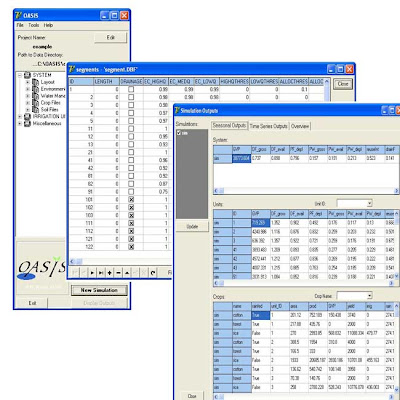The model is innovative in its systemic representation of an irrigation project (Figure 1) which includes groundwater and drainage system components. The groundwater system captures seepage from canals as well as deep percolation fluxes. It interacts with the drainage system, which collects runoff fluxes and canal spills. The included components and interactions provide OASIS with several novel features, notably:
- The ability to capture all the main factors of the water balance within an irrigation project, including non-process depletion from fallow lands and natural vegetation (non-irrigated land uses can be included as part of the upper soil compartment in Figure 1);
- The ability to capture and manage recycling of irrigation return flows, thus allowing conjunctive canal, groundwater and drainage water use.
The core of OASIS is a structure built on three nested levels, namely system, irrigation unit (IU) and field (Figure 2). OASIS defines a system as the command area of a main canal (or a main canal network) diverting water from a single source such as a river, a reservoir, a pumping station or another irrigation canal.
To account for the large-scale spatial variability of soils, land use, infrastructure, water availability and management, OASIS models an irrigation system as a set of interdependent geographical objects referred to as irrigation units. Each IU identifies the right or left side of the command area pertaining to a delimited reach of main irrigation canal. IUs are characterized in a lumped fashion, assuming that nothing is known about where features are located or how they are spatially distributed within their boundaries. Accordingly, IUs define the actual spatial resolution of the model. OASIS associates a distribution, groundwater and drainage system to each IU.
To account for the smaller-scale, intra-IU variability of soils, land use, irrigation practices and water availability, OASIS associates each IU with a set of fields. Fields are abstract, elementary land use units, each characterized by specific soil and land cover properties. They are not located in space and are modeled as 1-dimensional entities. Fields are generated by the model from the lumped description of IUs so as to provide an adequate representation of the soil and land use variability in these IUs. It is at the field level that the soil-crop-water interactions are simulated.


